Where In The Ocean Are You Likely To Find Animals That Make Their Own Light
Plumbing the Body of water Depths
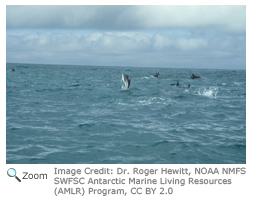 The open up ocean makes upwards almost 65 percent of ocean h2o. Information technology is the water away from the littoral waters and contains a wide variety of life. The ocean tin exist divided into two bones areas: the benthic zone or bounding main floor and the pelagic zone or ocean waters.
The open up ocean makes upwards almost 65 percent of ocean h2o. Information technology is the water away from the littoral waters and contains a wide variety of life. The ocean tin exist divided into two bones areas: the benthic zone or bounding main floor and the pelagic zone or ocean waters.
From Sunlight to Darkness
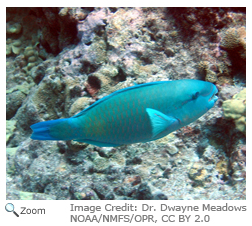 The pelagic region is divided into three zones. The top zone is the euphotic or sunlit zone. This is the ocean zone that sunlight penetrates. Because this zone gets sunlight, photosynthesis can occur and plants tin abound here. The sunlit zone goes down to near 660 feet. The adjacent zone is the dysphotic or twilight zone. Some sunlight reaches this zone, but not enough for photosynthesis to occur. The dysphotic zone goes down to about 3,300 anxiety. The last zone is the aphotic or midnight zone. No sunlight reaches this zone and it can reach depths of close to 20,000 feet. Sometimes people divide the midnight zone into ii zones: the aphotic zone and the abyss.
The pelagic region is divided into three zones. The top zone is the euphotic or sunlit zone. This is the ocean zone that sunlight penetrates. Because this zone gets sunlight, photosynthesis can occur and plants tin abound here. The sunlit zone goes down to near 660 feet. The adjacent zone is the dysphotic or twilight zone. Some sunlight reaches this zone, but not enough for photosynthesis to occur. The dysphotic zone goes down to about 3,300 anxiety. The last zone is the aphotic or midnight zone. No sunlight reaches this zone and it can reach depths of close to 20,000 feet. Sometimes people divide the midnight zone into ii zones: the aphotic zone and the abyss. Let the Sun Smoothen In
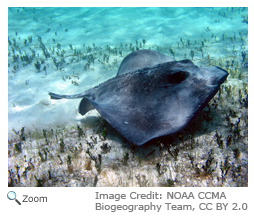 The sunlit zone is home to a broad variety of marine species considering plants tin can abound there and water temperatures are relatively warm. Lots of marine animals can be establish in the sunlit zone including sharks, tuna, mackerel, jellyfish, ocean turtles, seals and sea lions and stingrays. At that place are not a lot of places to hide in the sunlit zone! Some species take an adaptation called countershading. These animals are dark on the top and lighter on their undersides. When a predator is looking down on them from in a higher place, they blend into the darker waters below. When a predator is looking at them from below, they blend into the lighter waters above.
The sunlit zone is home to a broad variety of marine species considering plants tin can abound there and water temperatures are relatively warm. Lots of marine animals can be establish in the sunlit zone including sharks, tuna, mackerel, jellyfish, ocean turtles, seals and sea lions and stingrays. At that place are not a lot of places to hide in the sunlit zone! Some species take an adaptation called countershading. These animals are dark on the top and lighter on their undersides. When a predator is looking down on them from in a higher place, they blend into the darker waters below. When a predator is looking at them from below, they blend into the lighter waters above. Inbound the Twilight Zone
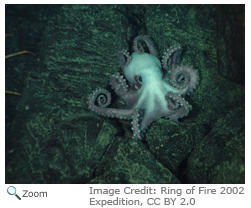 Animals that live in the twilight zone must be able to survive cold temperatures, an increase in water pressure and night waters. In that location are no plants in this zone, because there is non plenty light for photosynthesis. Octopus, squid, and the hatchet fish are some of the animals that can be found in this zone.
Animals that live in the twilight zone must be able to survive cold temperatures, an increase in water pressure and night waters. In that location are no plants in this zone, because there is non plenty light for photosynthesis. Octopus, squid, and the hatchet fish are some of the animals that can be found in this zone.
Many animals in this zone have thin bodies that help them hibernate from predators. Other organisms in this zone are ruby or black in color to ameliorate blend in with the dark h2o. When a predator is looking upward at them, they are and then thin that they are hard to see!
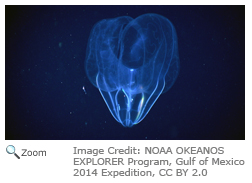 Some fish, like viper fish and the hatchet fish, take sharp fangs and big mouths that help them catch nutrient. Other fish have large optics that assistance them encounter in the dark waters. Most of the fish in this zone don't chase their food. They either stalk it or wait for information technology to float or swim by. Some animals that live in this zone make their own calorie-free with bioluminescence. They make light with special organs in their bodies called photophores. The photophores give off a greenish lite.
Some fish, like viper fish and the hatchet fish, take sharp fangs and big mouths that help them catch nutrient. Other fish have large optics that assistance them encounter in the dark waters. Most of the fish in this zone don't chase their food. They either stalk it or wait for information technology to float or swim by. Some animals that live in this zone make their own calorie-free with bioluminescence. They make light with special organs in their bodies called photophores. The photophores give off a greenish lite.
Deep in Darkness
It is very cold and completely dark in the midnight zone. Water pressure tin be as much every bit ii tons per foursquare inch. Life isn't like shooting fish in a barrel here and this zone has fewer organisms than the other zones. Considering at that place is no light in this zone, some animals don't have optics. In that location are no plants in this zone.
Source: https://nhpbs.org/natureworks/nwep6c.htm
Posted by: edwardshimpat.blogspot.com

0 Response to "Where In The Ocean Are You Likely To Find Animals That Make Their Own Light"
Post a Comment